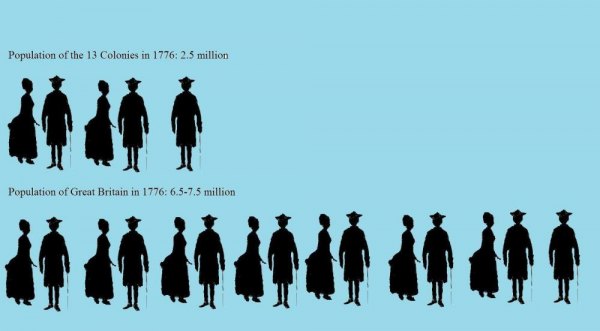
The chart below shows the total population of Britain’s colonies from the founding of Jamestown, Va., in 1607 to the 1790 census, the first census of the U.S. government.
1610 350 (all in Virginia)
1620 2,302 (Virginia and Plymouth Plantation)
1630 4,646
1640 26,634
1650 50,368
1660 75,058
1670 111,935
1680 151,507
1690 210,372
1700 250,888
1710 331,711
1720 466,185
1730 629,445
1740 905,563
1750 1,170,760
1760 1,593,625
1770 2,148,076
1776 2,500,000
1780 2,780,369
1790 3,929,214
The 13 Colonies by population in 1770
As the Revolution approached, this is how the Colonies ranked in size. The populations of four Colonies—Virginia, Massachusetts, North Carolina and New York—do not include certain territorial claims that became separate states after the Revolution.
1. Virginia 447,016
2. Pennsylvania 240,057
3. Massachusetts 235,808
4. Maryland 202,599
5. North Carolina 197,200
6. Connecticut 183,881
7. New York 162,920
8. South Carolina 124,244
9. New Jersey 117,431
10. Rhode Island 58,196
11. New Hampshire 62,396
12. Delaware 35,496
13. Georgia 23,375
Populated lands claimed by Colonies in 1770
These areas were parts of four Colonies during the Revolution but became separate states after the war. They are counted in the 2.1 million total for 1770 but were not included in the population of their associated Colonies, listed above.
Maine (part of Massachusetts) 31,257
Kentucky (Virginia) 15,700
Vermont (New York) 10,000
Tennessee (North Carolina) 1,000
Sources
1610 350 (all in Virginia)
1620 2,302 (Virginia and Plymouth Plantation)
1630 4,646
1640 26,634
1650 50,368
1660 75,058
1670 111,935
1680 151,507
1690 210,372
1700 250,888
1710 331,711
1720 466,185
1730 629,445
1740 905,563
1750 1,170,760
1760 1,593,625
1770 2,148,076
1776 2,500,000
1780 2,780,369
1790 3,929,214
The 13 Colonies by population in 1770
As the Revolution approached, this is how the Colonies ranked in size. The populations of four Colonies—Virginia, Massachusetts, North Carolina and New York—do not include certain territorial claims that became separate states after the Revolution.
1. Virginia 447,016
2. Pennsylvania 240,057
3. Massachusetts 235,808
4. Maryland 202,599
5. North Carolina 197,200
6. Connecticut 183,881
7. New York 162,920
8. South Carolina 124,244
9. New Jersey 117,431
10. Rhode Island 58,196
11. New Hampshire 62,396
12. Delaware 35,496
13. Georgia 23,375
Populated lands claimed by Colonies in 1770
These areas were parts of four Colonies during the Revolution but became separate states after the war. They are counted in the 2.1 million total for 1770 but were not included in the population of their associated Colonies, listed above.
Maine (part of Massachusetts) 31,257
Kentucky (Virginia) 15,700
Vermont (New York) 10,000
Tennessee (North Carolina) 1,000
Sources
- The 1610-1780 numbers, except for 1776, are estimates from the “Historical Statistics of the United States: Colonial Times to 1970,” issued by the Census Bureau, which cites as its main sources archival research and the statistical work of various scholars. The documents used by the researchers include reports by Colonial officials to an administrative group in London called the Lords Commissioners of Trade and Plantations, censuses conducted in individual Colonies, militia records, tax liens and estimates by Colonial officials themselves.
- The 1776 population figure is a separate Census Bureau estimate.
- The 1790 number is the official count in the first national census undertaken by the federal government under provisions of the Constitution of 1787. The original report on the 1790 census listed the country’s population as 3,929,326, but math errors showed 114 more people in Vermont than the correct count and two fewer people in Delaware than the correct count. Subtracting 114 and adding two equals 3,929,214.
Related:
Early colonists and the price of courage
Quick Study: What was the Sugar Act?
Men and women of the founding generation
The States: Admission to the union
If you would like to comment, contact us or like us on Facebook and tell us what you think.